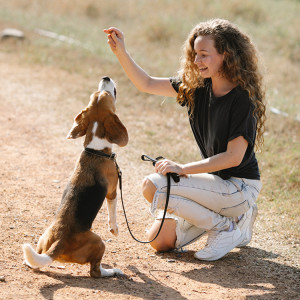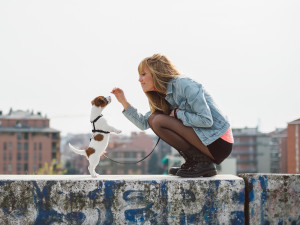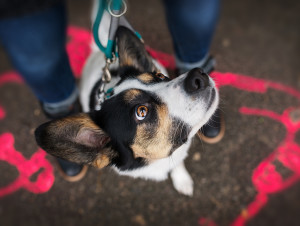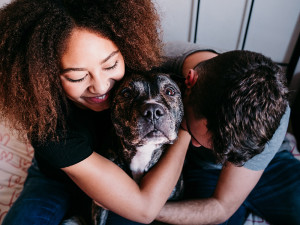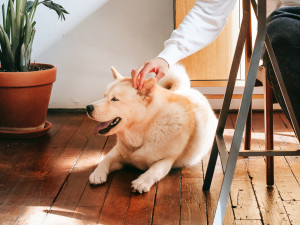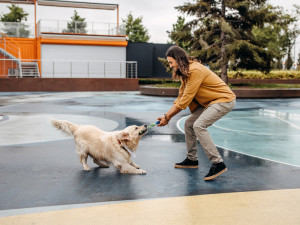Shocker: Food Is Still the Best Way to Reinforce Your Dog’s Good Behavior
Social interaction — aka praise — works, too. Who doesn’t like that?
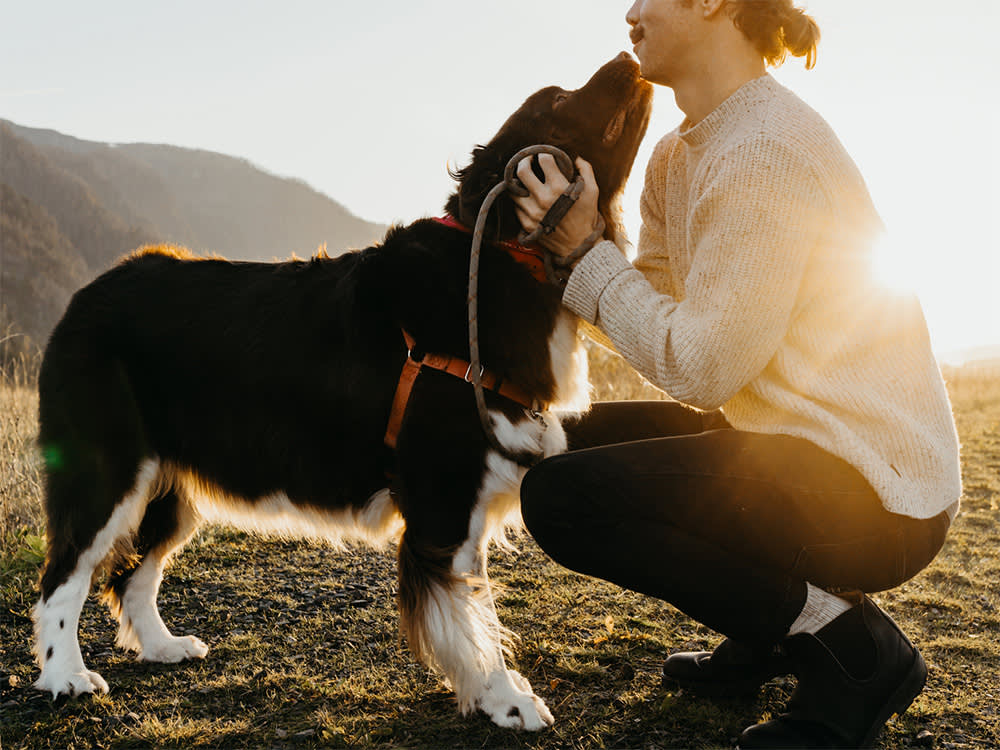
share article
“Do you reinforce him when he does what you ask?”
I frequently pose this question to my clients and one common response is, “Absolutely! I give him a treat every time.” Another answer I often hear is, “Yes, I always praise him and pet him, too!” Well, the good news, based on a March studyopens in a new tab, “Social interaction can function as a reinforcer for dogs: Effects of stimulus duration and session parameters,” by Erica Feuerbacher, Caitlin Togher, and Jonathan Friedel is that both responses — attention and food — can act as reinforcers to dogs, which makes them more likely to perform the desired behavior in the future.
Attention is great. Adding food makes it more effective.
In other words, you can train your dog using social interaction, and you can train your dog with food. But (spoiler alert!) research indicates that food is more effective, at least for some dogs. Having options, both backed by evidence from scientific research, is an excellent development in the field of science-based training, and a cause for celebration. As the authors write, “Our results suggest both durations of social interaction can function as a reinforcer, especially when delivered sporadically, but they are still not as effective as food as a reinforcer for most dogs.”
According to Feuerbacher, “Amazingly, despite what we have learned about dogs and as much as we interact with them, we didn’t really have any data showing clearly that human social interaction could or does function as a reinforcer for dogs. Ours was the first to clearly show that. It’s likely what many owners experience, but it’s always good to have data to back up our anecdotal observations. However, I think it’s worth pointing out that it’s not as effective, typically, as food still. So, we can use human social interaction as a reinforcer, but it likely needs to be interspersed with other valuable reinforcers.”
Basically, your dog gets bored of getting positive attention without a treat.
Previous studies have shown mixed results about whether social interaction can function as a reinforcer, but in studies that found social interaction to be ineffective, the reason may have been because dogs get satiated on it quickly. In the current study, trials were spaced out over a long time period to avoid that problem.
In this study, the behavior used to evaluate potential reinforcers was targeting to a hand, or “touch” as it is frequently called. Dog parents held their hand at dog nose level for 30 seconds or until the dog touched the hand with their muzzle. The parent’s response varied across sessions, but they offered the planned reinforcer, whether that was four seconds of petting and praise, 30 seconds of petting and praise, or a verbal marker (“yip”) followed by food. In trials with no reinforcement, the person lifted their hand in response to muzzle touch, waited four seconds, and then did the next trial. If the dog did not perform the “touch” behavior within the 30 seconds, the person removed their hand, and then started the next trial. There were 10 trials in each session, and the data were the number of touch responses per session.
Here’s how the social interaction study worked.
The length of time for social interactions was chosen very thoughtfully. Feuerbacher says, “I chose four seconds because I had tested four seconds of social interaction in a previous paper because it was similar in time to how long it took me to deliver a piece of food to a dog; in that paper we found it was not very useful as a reinforcer, but we had different experimental parameters in that study (the sessions were back to back, with potentially greater numbers of trials, and interspersed with a food condition). So, I wanted to evaluate that under these new parameters.” She goes on: “I also chose 30 seconds because another paper from other researchers had suggested that 30 seconds of social interaction was as effective as food for training dogs, but their study had some confounds. So, I wanted to clean that up and look at both of these that had had some published research on them already.”
The study did not find that the duration of social interaction made a difference in the touch behavior of dogs, but one dog did a lot more barking after receiving four seconds of social interaction than after experiencing 30 seconds of social interaction or after being given food following a correct response.
Dogs generally responded more in sessions with social interaction than to sessions in which the pet parents offered no response. When comparing responses to social interactions versus food, two of the dogs responded to all cues to touch the hand in either condition, and one dog responded twice as much in the sessions in which food was offered compared with those in which social interaction was offered.
Individual variation, which is to be expected, is always important to consider, and it’s something that Feuerbacher is well aware of: “We saw some dogs that responded maximally for social interaction and others that didn’t. I think this highlights that owners need to pay attention to their dogs and find out what is meaningful and valuable to their dog. For some dogs, social interaction might be very valuable and a useful training option, but for others, they might not find it as reinforcing, and food or play are better options.”
If you don’t have treats on you, positive attention is still a great tool.
We know from previous research (not to mention a lot of people’s personal experiences!) that food works as a reinforcer, but it requires extra work for pet parents. Some people don’t want to use food, and allergies can be an issue in some households. The advantage of social interaction as a reinforcer is that people always have it available. You can leave your treats behind, but your ability to pet and praise your dog is always on hand, and that may be useful in persuading people to use positive reinforcement when training their dogs. Because social interaction requires no preparation ahead of time, it’s easy, and that may be all it takes for some people to turn to positive-reinforcement training.
Vocal praise is great, but your dog especially loves it when you pet them.
This study used both petting and praise combined for social interaction, but Feuerbacher thinks these are not equally valuable to dogs, saying, “While we didn’t directly explore whether it was petting, or vocal praise, or both contributed to the effect we saw, our prior research suggests it was likely petting that was driving our results. We have found no effect of adding vocal praise to food delivery on the efficacy of food as a reinforcer, and in other studies, dogs preferred petting much more than vocal praise.”
There is so much more to investigate about the value of social interaction for reinforcing canine behavior, and Feuerbacher is full of ideas for future studies. Of particular interest to her is what happens in more distracting situations: “I would really like to test social interaction as a reinforcer in a noisier environment — like outside or in a park. I suspect we might see that it can function as a reinforcer in settings where there is not a lot of other fun things for dogs to engage in, but might not function as well when competing with other environmental reinforcers such as good smells, other dogs, or squirrels!”
Spoken like a scientist who knows, understands, and loves dogs — just like the rest of us.

Karen B. London, PhD, CAAB, CPDT-KA
Karen B. London, Ph.D., is a Certified Applied Animal Behaviorist and Certified Professional Dog Trainer who specializes in working with dogs with serious behavioral issues, including aggression, and has also trained other animals including cats, birds, snakes, and insects. She writes the animal column for the Arizona Daily Sun and is an Adjunct Professor in the Department of Biological Sciences at Northern Arizona University. She is the author of six books about training and behavior, including her most recent, Treat Everyone Like a Dog: How a Dog Trainer’s World View Can Improve Your Lifeopens in a new tab.
Related articles
![Couple hugs their merle Boxer]() opens in a new tab
opens in a new tabHow to Improve Your Relationship with Your Dog
Animal behaviorist Dr. Karen B. London on how to strengthen your pet-parent bond.
![Unrecognizable man sitting at desk petting his dog]() opens in a new tab
opens in a new tabHow to Pet a Dog — Yes, You Do Need Lessons
There’s a difference between being affectionate and being annoying.
![Two colorful Great Danes illustration.]() opens in a new tab
opens in a new tabEver Ask Your Dog “Why Are You Like This?” DNA Is the Answer — Kind Of
This study says it’s actually less about what’s in their DNA and more about what’s on it.
![A woman walking 5 dogs on leashes outside.]() opens in a new tab
opens in a new tabBreed Does Not Equal Behavior—Here’s Why
A new study found that a dog’s breed accounts for less than 10 percent of their behavior.
![A man with long brown hair playing tug -of-war with his Golden Retriever dog outside on a wet tennis court]() opens in a new tab
opens in a new tabPlay-Training Can Be Your Solution to Dog Aggression
Behavior correction, Mary Poppins style: Turn a job into a game.
![Afghan hound dog mid jump in an open grass field]() opens in a new tab
opens in a new tabOverexcited Dog? How to Calm A Dog Down
If your dog loses their sh*t over anything—from a squirrel to a guest. Here are some tips to curtail that.
